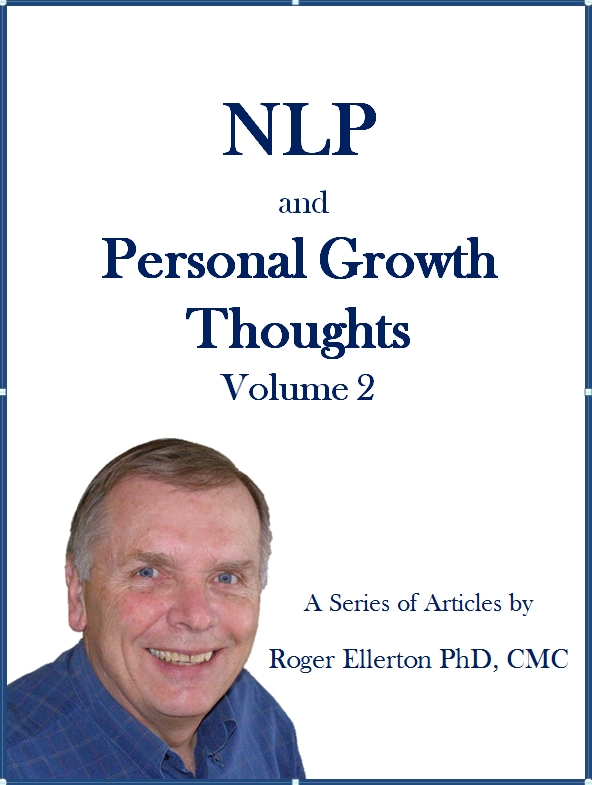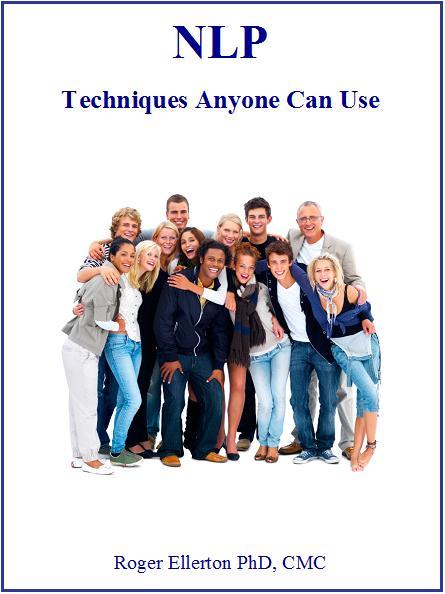NLP Meta Programs, Part II
By Roger Ellerton Phd, ISP, CMC, Renewal Technologies Inc.
This article may not be republished without written permission from Roger Ellerton/Renewal Technologies Inc. If you republish this article without permission, you will be in violation of copyright law and sent an invoice. You may share this and other pages with your friends by linking directly to this page from your website or blog.
In the article, Meta Programs, Part I, we introduced two types of Meta Programs (based on the LAB Profile ®) - Motivation Traits and Working Traits and presented a brief discussion on three Motivation Traits. In this article, we present two more Motivation Traits, and three Working Traits.
Motivation Traits
1. Proactive - Reactive
Does the person tend to initiate or prefer to wait for others to lead?
Proactive: This group tends to initiate and not wait for others. From a reactive's point of view, they act with little or no consideration; jump into situations without thinking or analyzing and bulldoze ahead with what they want to do. They are very good at getting the job done. To motivate/influence these people, use words such as: go for it, just do it, why wait, take charge, what are you waiting for, time to act, ... . To identify these people, notice if they use short sentences with an active verb, speak as if they are in control and have difficulty sitting still for long periods of time. These people do well in situations where something needs to be done now - e.g. outside sales, project manager (when getting the job done is more important than the 'feathers that may get ruffled').
Reactive: These people have a tendency to wait for others to initiate or until the situation is right. They may spend substantial time considering and analyzing without acting. They want to fully understand and assess before acting and believe in chance or luck. They are motivated by words such as: consider the following, let's investigate this further, analyze this, look into this in more detail, we need to understand this, this time we will be lucky, ... . To move them from over analyzing, you may wish to say "now that you have had time to consider this, it is time to act". This group can be identified through their use of long complex sentences or incomplete sentences, use of passive verbs and nominalizations (verbs transformed into nouns e.g. communication rather than communicate), use of conditionals (would, should, could, might, may). They will also speak in terms of outside forces having a major influence on their lives and relying on luck or chance or the need to understand/analyze before acting. They are capable of sitting and analyzing/exploring an issue for long periods of time. Positions suited to these people would be analysts or customer service representatives.
Distribution (in a work context): Proactive (15 - 20%), Proactive and Reactive (60 - 65%), Reactive (15 - 20%). Since the vast majority of people fall into the middle category, the usual practice is to assume a person is in this group unless they exhibit the characteristics of one of the extremes.
2. Sameness - Difference
Does a person look for things that are the same or different?
Sameness: They want their world to stay the same. They may accept change every 10 years and will instigate change only every 15 to 25 years. To motivate these people, point out how things have not changed, that they are still doing the same type of work. Use words such as: same as, similar to, in common, as you always do, like before. They are best suited to work environments that do not change or change very slowly over time.
Sameness with Exception: These people like to see change happen slowly over time. They look for significant change every five to seven years. Words that motivate these people are: improved, better, more/less, same except, budding, developing, gradual improvement, advanced.
Difference: Change is a way of life for this group - habitual and far-reaching. They expect or will orchestrate major change every one to two years. Motivating words include: new, fresh, totally different, completely changed, radical idea, novel. If you are looking for radical change in your organization, these are the people who will lead it and of course, they are the people who are demanding it!
Sameness with Exception and Difference: This group expects major change every three to four years. They like a balance between progress and major upheaval. Motivating words would include a combination of those used for the sameness with exception and difference groups.
How to identify the different groups: You could ask the following question: "What is the relationship between your work (home, vacation) this year and last year?" Listen for the words listed above. Even if they have changed jobs during the past year, Sameness people may talk about what the two positions have in common, that things really have not changed. Sameness with Exception people will talk about how things are evolving or will talk about similarities and then differences, while Differences people may not understand the word 'relationship', as there is no relationship between what they are doing now and last year. Sameness with Exception and Difference people will have a blend of the difference and sameness with exception answers.
Distribution (in a work context): Sameness (5%), Sameness with Exception (65%), Difference (20%), Sameness and Difference with Exception (10%)
Many years ago, one of my tasks was to introduce microcomputers and word processors into the workforce to replace typewriters. As you can imagine, I encountered people from all of the above groups. For the differences people, the change was not significant or fast enough, for the sameness people, things were moving far too fast and I continually had to point out all the things that were the same - same organizational structure, same process for processing the letter/document, same type of keyboard, ... .
Motivational Traits - Concluding Thought: We have discussed each of the traits separately. To get greater insight, look at various combinations. For example, what would most likely be the Meta Programs for an entrepreneur? Suggest: towards, internal, options, proactive and differences. Rodger Bailey talks about a highly successful entrepreneur with the following pattern: towards, external, options, proactive and differences. This person compensated for his lack of internal referencing by hiring a business coach, from whom he could get external feedback!
Working Traits
1. Specific - General
Does the person prefer to work with details or the big picture?
Specific: This group prefers to work with small pieces of information and lots of details and facts. They see information in linear sequences and may have difficulty drawing it together to form an overview or big picture. They can be identified through their speech patterns that will have a definite sequence and contain lots of detail (adverbs, adjectives, proper names of people, places and things). Motivating language includes: providing lots of detail in a clearly defined sequence and using words such as exactly, in particular, specifically. These people make good assembly line workers and bookkeepers, as they enjoy working with details for long periods of time.
General: People in this group prefer to work at the theoretical, abstract or big picture level and, if necessary, can work at the detail level but will become bored or frustrated quickly. Their thoughts may seem disconnected as they describe various aspects of the big picture, which they see in its entirety. When they speak, they may provide an overview or present abstract concepts in a simple sentence with few modifiers or details. To motivate these people, you need to avoid details, describe the big picture and look for generalizations. People in this group would not make good pharmacists as they do not focus on details and hence would make too many mistakes. They are good at planning and developing strategies and make good project managers or people managers.
Distribution (in a work context): Specific (40%), Specific and General (20%), General (40%)
2. Self - Others
Is the person focused on their own internal experience or on the non-verbal behaviour of others?
Self: This group does not tend to show emotions, although they do have them. They are focused more on the content of a conversation rather than the non-verbal communication - body language, tone of voice or level of rapport - and have difficulty establishing and maintaining rapport. They are not skilled at interpersonal communication as they assess the quality of the communication on their own feelings and not the reactions they are getting from other people. To identify these people, notice if they react to the content of the conversation rather than your body language or tone of voice. As well, they will show little facial expression or voice variation. If you accidentally dropped a pencil or book, they would tend to ignore it and expect you to pick it up. To influence these people, focus on the content of your message - they do not respond to hints or sarcasm. These people are best suited for technical positions where their interaction with other people is not critical to getting the job done.
Others: These people tend to be more animated and respond the body language (including facial expressions) and tone of voice of the other person. They assess a conversation at a conscious or unconscious level based on their observation of the other person. They tend to be good at establishing and maintaining rapport. These people can be identified from their animated behaviours, body language and changes in voice tonality to match the content of their communication. If you accidentally dropped a pencil or book, their natural tendency is to pick it up for you. They are most influenced by the depth of rapport established. These people make good customer service representatives.
Distribution (in a work context): Self (7%), Others (93%)
3. Independent - Proximity - Co-operative
Does the person prefer working alone, with people close by or as part of a team?
Independent: These people prefer to work alone and have sole responsibility for getting the job done. If they have to work with others or share responsibility, their productivity may decrease. They prefer to work with their office door closed or in isolation and do not readily consult other people. If you ask these people about a particularly enjoyable work experience, they will talk about what they did and not mention others playing a role in completing the task or in sharing responsibility. To influence these people, give them total responsibility and make it clear that they alone will work on this task. These people are most productive when they work independently, even if the work environment around them is chaotic.
Proximity: This group enjoys having clearly defined responsibilities and being in charge. They need others to be involved, without sharing responsibility or control. If you ask these people about a particularly enjoyable work experience, they will talk about what they did and infer that other people assisted in getting it done (e.g. my team (but I am the captain!)). To motivate these people put them in charge and provide them with subordinate staff to direct. This is a good attribute (with a small dose of co-operative) for managers.
Co-operative: These people enjoy working with others where responsibilities and control are shared with others - a team, where everybody takes turns leading or sharing the lead and responsibilities. If you ask these people about a particularly enjoyable work experience, they will talk in terms of 'we', 'us', 'our team' and that the responsibility and accomplishments are a result of everyone's contribution. To motivate these people, talk about shared responsibility, we are all in this together, and use the words 'we' and 'us'. These people are ideally suited to a team environment that requires sharing of responsibilities and work tasks.
Distribution (in a work context): Independent (20%), Proximity (60%), Co-operative (20%)
As mentioned in the previous article, Meta Programs are very useful in marketing, selling, team building, organizational change, presentations, negotiation, hiring staff, selecting your ideal job; as well as interpersonal relationships at home. To be most effective, you should have an understanding of your preferences and be sufficiently flexible to communicate with people in terms of their model of the world. For a comprehensive discussion of Meta Programs, see the book by Shelle Rose Charvet titled Words that Change Minds: The 14 Patterns for Mastering the Language of Influence.
And NLP is Much more than that!
Author: Roger Ellerton is a certified NLP trainer, certified management consultant and the founder and managing partner of Renewal Technologies. The above article is based on his book Live Your Dreams Let Reality Catch Up: NLP and Common Sense for Coaches, Managers and You.
Copyright © 2004, Renewal Technologies Inc. All rights reserved.








